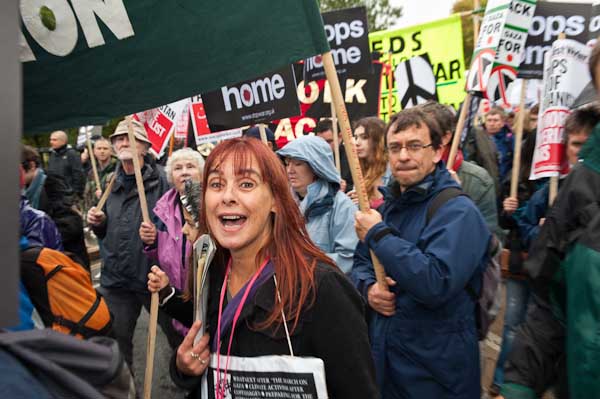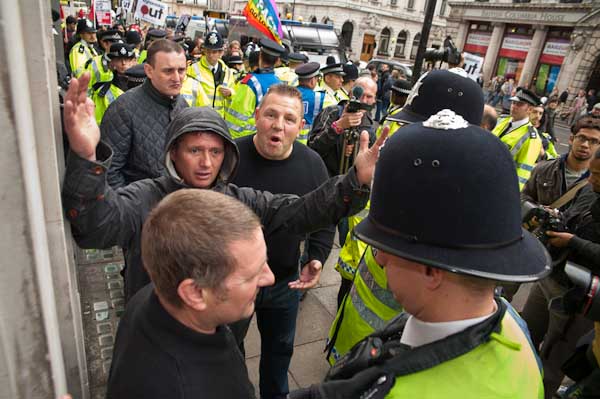If the suggestions – as reported in the Amateur Photographer – of the Information Commissioner’s Office (ICO) about a ‘Privacy Code for online use of photography‘ on the streets were to be adopted it would be the end of photography as we know it on the web. Their proposals seem to me ridiculous and unworkable – and my immediate reaction was to check the date of the article by Chris Cheesman. But to my surprise I found it was written on 27 Sept rather than April 1.
The proposal are frankly ridiculous in several respects, but particularly in the attack that they make on news reporting, with the suggestion that it would become necessary to blur many faces in images for publication in newspapers and also on websites – except for social networking and similar sites. The AP reports that while “background shots of passers-by will not normally breach the Data Protection Act, images of a small group of clearly identifiable people, sent for publication to a newspaper for example, may be considered an infringement.” So it becomes clear that this is not just a threat to what can be published on the web, but also to the freedom of the press as a whole.
The proposals according the AP report “will not prevent someone taking photos in the street without the subject’s consent, provided that the images are for ‘personal use’ and the camera is not being used to harass people” but it will severely restrict what you can do with them. Stick them on Facebook or in your family album and you are fine, but publish them – even on Flickr – and it looks as if you may be damned.

Taking part in a demo on the street implies a willingness to be seen and photographed. More picture from ‘Bring the Troops home from Afghanistan‘
I mainly photograph public events and demonstrations, where those taking part know they will be under the gaze of cameras and thus implicitly grant permission to be recorded. At times I photograph the people who are standing on the street or in shop windows watching (and sometimes also photographing) events and it seems only a fair reciprocity that they too should expect to be watched and photographed. And it is clearly important that in situations involving crime, potential crime or unrest that journalists – including citizen journalists – should where possible record both potential criminals and the activities of the police, and that news media – print, broadcast and web – have a public duty to publish such images. Whatever the feelings of those who appear in them, or indeed the Terrorism Act, unless the pictures would clearly be of aid to terrorists.

Reporting on the police is important for a free press. More pictures from this incident involving football supporters attempting to disrupt the Bring the Troops Home rally.
I actually follow my own test that differs significantly from that which the woman speaking for the ICO suggests. Rather than asking “whether the subjects would object to their picture being published in this way”, I think “whether a reasonable person photographed in this way would have a reasonable objection to having this particular picture published.” It seems to me to be an important and fundamental difference, not least in that a “reasonable person” is also a reasoning person, while many of the objections that people have made about the use of their pictures have been purely on emotional grounds.
If someone walks down a street with a silly hat on, I don’t think they can reasonably object to a picture that shows them wearing a silly hat on the street, but if I have managed to catch them at a moment or from an angle that makes a perfectly normal hat look silly their objection might well be sustained. There is sometimes a fine line between being amusing and demeaning the person, but in general I think the distinction is clear.
Any test should probably also distinguish between people “in the public eye” who have chosen to live and profit from being public figures, and those in whom there is no genuine public interest. Although I usually chose to delete or not use images of – for example – politicians in which a momentary gesture makes them look silly, it would make the reporting of party conferences in particular rather boring if all were disallowed. And of course our current London mayor has made his political career on being seen as a buffoon (so perhaps we should not encourage him.)
So far as privacy is concerned, at present we have a fairly clear position – “a reasonable expectation of privacy” – which offers a reasonable degree of protection to people while allowing publication of news etc. There seems little if any need for any further restriction. We also have the law of defamation that restricts the use that can be made of images of people, and although too it isn’t entirely satisfactory it largely does the job required in limiting the activities of publishers.
It is perhaps an interesting question whether a photograph in isolation is actually personal data. If I publish a picture of you without any accompanying text, only those who already know what you look like will be able to identify the picture as being of you. Without being incorporated into a structure with accompanying data the image to the wider public remains anonymous.
Photographs only truly become data when, for example, they are put into a police database and used to produce “spotter cards” for use by police at demonstrations, or when they are displayed on a right-wing hate web site along with names and other data with the intention of encouraging violence or other illegal acts against demonstrators and journalists (thanks to Marc Vallée for the anonymised link posted on Twitter.)
I’ve published literally thousands of pictures of children over the years, but I’ve always been careful not to give names except in very special circumstances. At times I’ve blurred name badges on them – (and some pictures of adults) – in order to preserve a certain anonymity. I’ve generally only named adults in pictures who are in some sense public figures – if at times in a very local and minor way. There might I think be some sense in restricting or at least reviewing the local paper practice of giving names and ages in picture captions, although local papers are becoming a thing of the past in any case.
Increasingly we are moving from still images to the use of video, and here the problems that the suggested regulations would produce seem more or less insuperable. Could we really have online newspapers without news pictures and online TV without news film from the UK? It does appear to be what the ICO proposals might produce.